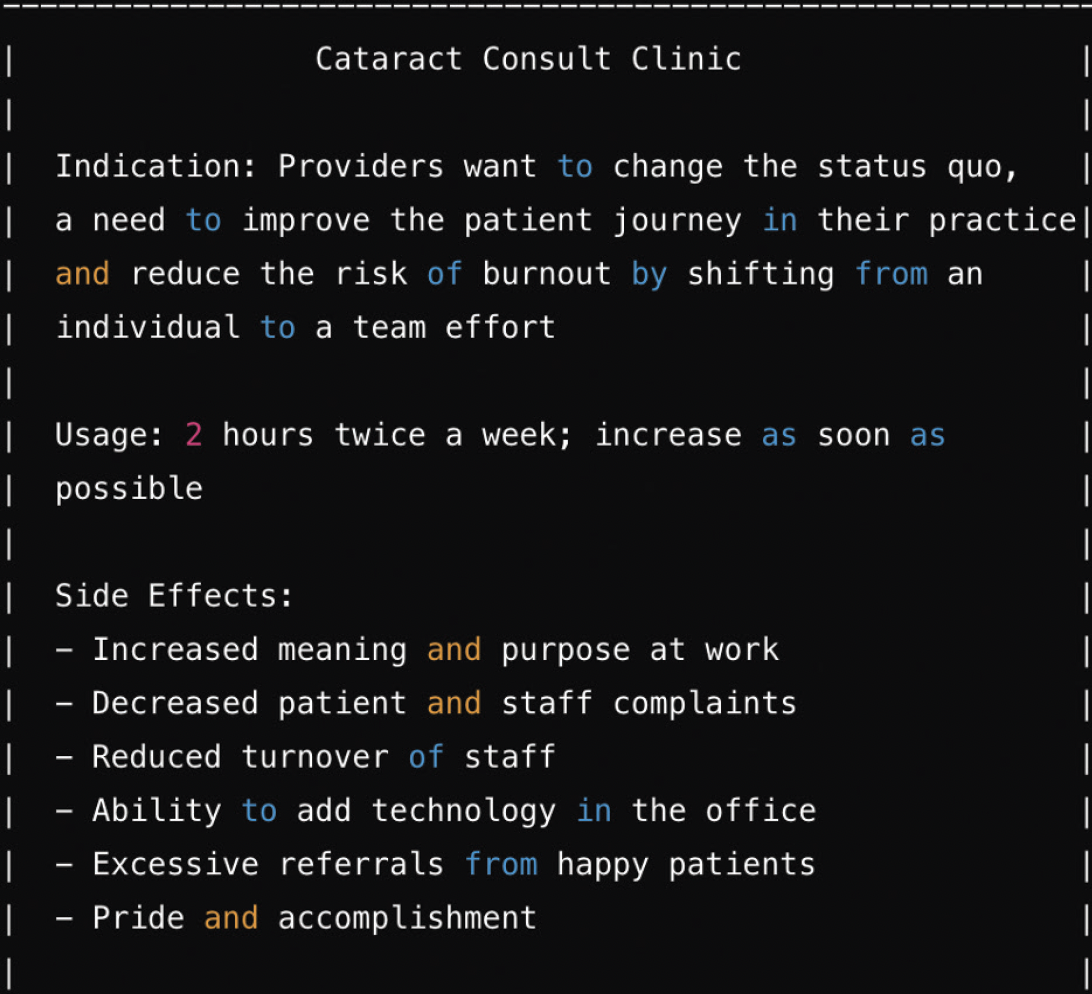
Does the following sound familiar? It is almost 1 pm, and you are in the middle of a new cataract consult with a patient who is an engineer holding 2 handwritten pages of questions about refractive options. Your technician is running behind, dealing with annoyed patients who have been waiting too long, and she forgot to refract this patient and perform glare testing to document his BCVA. You are faced with the choice of interrupting her to return to the room or doing the work yourself.
You just finished explaining the concept of extended depth of focus to the patient, who is poised to ask another question. You are hungry and running about an hour behind, and you realize you neglected to order lunch. Additionally, you are aware that two patients have been waiting for more than half an hour for what you told them would be an “in-and-out eye pressure check.”
Some version of this scenario occurred daily in my practice, causing stress for my staff, my patients, and myself. I decided there had to be a better way to schedule my day. Building a patient and provider referral cataract practice required reaching beyond my surgical skills and focusing on the patient experience at all touchpoints. In times like these, I find that dissatisfaction with the status quo can be healthy.
WORK ON YOUR PRACTICE, NOT FOR YOUR PRACTICE
Scattering cataract consults throughout the day disrupts the continuity of care for all parties involved. Technicians must juggle various types of patients, often resulting in cataract workups that lack crucial components. This, in turn, compels interruptions for additional testing, dilation, and refraction. The inefficiency frustrates both the provider and the patient and leads to negative interactions with technicians struggling to keep up with the day’s schedule.
Creating a cataract-only consult section in our clinic has allowed my team and me to focus on the total patient experience, not just excellent surgical outcomes. Investing time in this specialized clinic has optimized our workflow, prioritized the patient experience, and enabled us to gather feedback and make continuous improvements. I no longer feel pulled through my day. Instead, there is a team effort to provide a best-in-class patient experience within our practice (Figure).

Figure. Prescription for success with a cataract-only consult clinic.
TEST IT OUT
Planning
To test the concept, I created a 2-hour cataract-only clinic to be held twice a week—first thing on Monday mornings and Thursday afternoons right after lunch. I met with the front desk and testing staff, ophthalmic technicians, and surgical scheduler to outline the cataract patient’s journey from their initial phone call to their discussion with the surgical counselor after the exam. Everyone had an equal voice at the meeting. In fact, we left an empty chair in the room to help us imagine a patient sitting there, ensuring that each decision focused on their experience.
We developed a script for the front desk staff to use when making appointments. This script covers critical information, including the consult’s typical duration, the use of pupillary dilation, and the value of bringing a companion to the visit to absorb information and drive the patient home afterward. We also created a checklist for technicians to use during the exam to ensure all necessary information is obtained before I enter the room. Items on the list include inquiring about a history of ocular trauma, documenting the impact of poor vision on activities of daily living, and performing glare testing and refraction.
Patients were scheduled every 20 minutes, allowing each team member to carry out the roles established in our plan. Patients received clear communication about what to expect during each step of their journey. Information was carefully provided at specific touchpoints to prevent them from becoming overwhelmed and incapable of making decisions.
Fine-Tuning
When we tested our carefully orchestrated cataract-only clinics, we found that we were ready and relaxed. Some exams lasted only 10 minutes, whereas others took 25 minutes to address complex concerns or set realistic expectations. After each clinic, our team discussed what worked and what didn’t. Everyone was eager to improve the patient experience. We functioned as a team, and it felt great.
One change we implemented was to mail forms to patients to fill out at home because the process was taking some of them 30 minutes after arriving at the office. Another change was obtaining patients’ records from referring optometrists. This helped us with the history and provided our technicians with an updated refraction, giving them a head start on their day. We also created an algorithm using the patient’s anterior chamber depth and current glasses prescription to facilitate safe pupillary dilation.
The most significant change we made was initiated by our team, who asked me to create a video for patients to watch while their pupils were dilating. In the video, I review general information on cataract surgery and its risks. This video has been a game changer because I no longer have to deliver the same spiel at every consult.
Our team formally solicited patients’ feedback on how we could improve the cataract consult. As a result, team members now wear name tags displaying their titles, clearly introduce themselves, describe their roles in the patient journey, and explain the relevance of any testing they perform. These changes eased patients’ anxiety during their visits and helped the staff recognize their essential role in patient care.
We quickly realized that some types of patients were incompatible with the cataract-only clinic. These included patients who decided to return for cataract surgery on their second eye months after the procedure on their first eye and individuals who delayed their original surgery for 6 months and needed an updated exam. Initially, these patients were added to the clinic’s regular schedule so they did not occupy a valuable cataract consult clinic spot. Over time, however, we transitioned to double-booking consult clinic spots.
We also discovered that limited time blocks do not work well for all patients. In response, the front desk was asked to remain flexible when offering consult times. If a patient has trouble visiting during one of our cataract-only clinics, they are offered a regular appointment slot.
MAKE A COMMITMENT
To have the practice you want, commit to changing the practice you do not want. Redirect negative energy—running behind schedule, shortened lunch breaks, stress over prolonged exams, and patients’ perception of chaos in the office—into improving the patient journey. Establishing a cataract-only consult clinic can transform fragmented, on-the-fly care into a coordinated team effort that increases efficiency and enhances the patient experience. Happy patients are more likely to refer their friends and family members. Eventually, 2-hour clinics may become full-day cataract consults.




